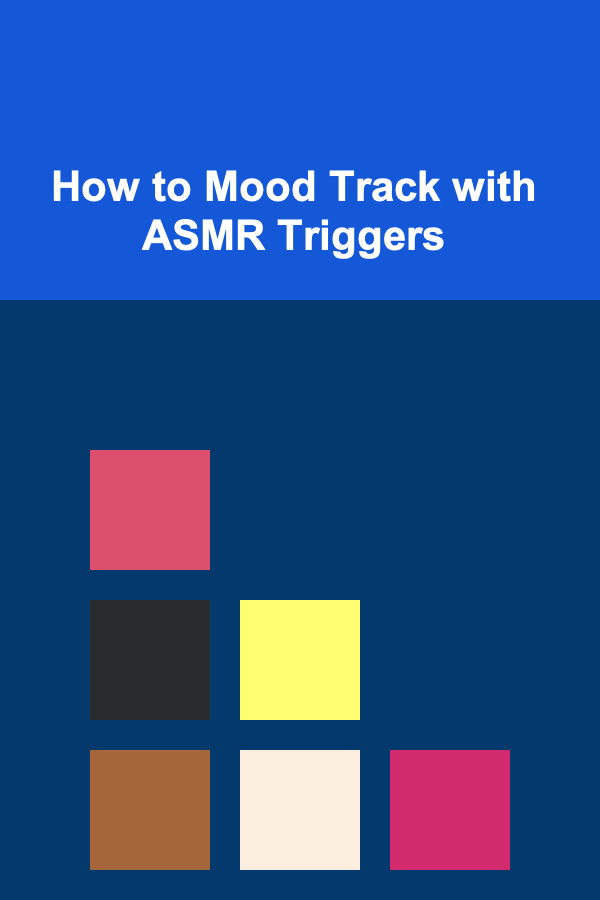
How to Mood Track with ASMR Triggers
ebook include PDF & Audio bundle (Micro Guide)
$12.99$5.99
Limited Time Offer! Order within the next:

ASMR, or Autonomous Sensory Meridian Response, is a phenomenon where specific auditory or visual stimuli can trigger a tingling sensation, typically felt around the scalp or neck area. The sensation is often accompanied by a sense of calm and relaxation, making it a popular method for reducing stress and improving sleep quality. However, recent research and anecdotal evidence have suggested that ASMR can also be used effectively for mood tracking.
Mood tracking is the practice of monitoring your emotional states over time to identify patterns, triggers, and areas of improvement. Traditionally, people track their moods through journaling, apps, or self-reporting, but the integration of ASMR into mood tracking can provide a unique and sensory-rich approach to better understanding your emotional fluctuations.
In this article, we will explore how ASMR triggers can be used as a tool for mood tracking. We'll discuss the science behind ASMR, how it can help you identify and track your emotions, and practical tips for incorporating ASMR into your mood tracking routine.
Understanding ASMR
Before we dive into how ASMR can be used for mood tracking, it's essential to understand what ASMR is and how it works. ASMR is a tingling sensation that some people experience in response to specific triggers, such as soft whispers, tapping, crinkling, and gentle movements. This sensation is often accompanied by feelings of relaxation, calm, and even euphoria. It has been described as a pleasant "shiver" or "tingling" that travels from the head and down the spine.
ASMR is often used as a form of relaxation or stress relief, with many people using ASMR videos or audio recordings to help them fall asleep, manage anxiety, or simply unwind after a long day. Despite the popularity of ASMR in recent years, the scientific community is still exploring its mechanisms, and much of the research on the subject remains in its early stages. However, many experts believe that the tingling sensation and relaxation associated with ASMR are due to the brain's response to certain sensory stimuli, which may have a calming effect on the autonomic nervous system.
The Connection Between ASMR and Mood Tracking
Mood tracking involves observing and recording your emotional states over time. It allows you to gain insights into your feelings, identify patterns, and recognize potential triggers for your moods. Traditionally, mood tracking is done through methods such as journaling, digital apps, or self-reports. While these methods can be effective, they may not always capture the sensory experiences or physiological responses that accompany emotional changes.
This is where ASMR comes into play. ASMR has a unique ability to trigger specific emotional and physiological responses in the body, making it a powerful tool for mood tracking. By paying attention to your ASMR reactions---whether they induce relaxation, happiness, anxiety, or sadness---you can gain a deeper understanding of how your body responds to different emotional states.
For example, you may notice that certain ASMR triggers, such as soft whispers, help you feel calm and relaxed when you're stressed or anxious. On the other hand, you may find that certain sounds or visual cues make you feel tense or uncomfortable. By tracking these reactions over time, you can identify patterns in your mood and gain valuable insights into what triggers positive or negative emotional responses.
How to Use ASMR for Mood Tracking
Now that we understand the connection between ASMR and mood tracking, let's explore how you can integrate ASMR triggers into your mood tracking routine. Here are some practical tips and steps to help you get started:
1. Identify Your ASMR Triggers
The first step in using ASMR for mood tracking is to identify your personal ASMR triggers. Different people respond to different stimuli, so it's essential to explore and find out what works best for you. Some common ASMR triggers include:
- Whispering: Soft-spoken voices or whispers are one of the most common ASMR triggers. The soothing sound of whispers can promote relaxation and calmness.
- Tapping: The sound of fingers gently tapping on various surfaces, such as wood, glass, or plastic, is another popular trigger.
- Crinkling: The sound of crinkling paper or plastic is often associated with ASMR and can create a calming effect.
- Personal Attention: ASMR videos that simulate personal attention, such as hair brushing or gentle facial touch, can make viewers feel cared for and relaxed.
- Nature Sounds: Sounds of rain, waves, or birds chirping can also trigger ASMR and induce a peaceful state of mind.
Take some time to explore different ASMR videos or recordings and note the triggers that produce the most noticeable and enjoyable effects. Keep track of the sounds, visuals, or sensations that make you feel relaxed, happy, or calm.
2. Use a Mood Tracking Journal or App
Once you've identified your ASMR triggers, the next step is to start tracking your moods alongside your ASMR experiences. You can use a mood tracking journal, a digital app, or a simple spreadsheet to record your emotional states and any ASMR triggers you've experienced.
In your journal or app, create sections to note the following:
- Date and time: When did you listen to ASMR? Record the time of day and whether the ASMR session was during a stressful or calm period.
- Mood rating: Rate your mood before and after the ASMR experience. Use a scale from 1-10 (1 being very negative and 10 being very positive) or simple words like "happy," "calm," "anxious," or "stressed."
- ASMR triggers used: Write down which specific ASMR triggers you experienced, such as whispering, tapping, or crinkling. This will help you see which triggers are linked to positive or negative moods.
- Physical sensations: Note any physical reactions, such as tingling sensations, relaxation, or increased tension. These physical responses are essential in understanding how ASMR affects your emotional state.
3. Experiment with Different ASMR Triggers
To get the most accurate mood tracking results, it's essential to experiment with different ASMR triggers and see how they impact your emotions. Spend a few days focusing on one particular trigger, such as whispering, and track how it makes you feel before and after listening. Then, switch to another trigger, such as tapping, and compare the results.
This experimentation will help you identify which ASMR triggers are most effective for improving your mood and which ones may evoke more neutral or negative responses. Over time, you can create a personalized list of ASMR triggers that are most beneficial for your emotional well-being.
4. Pay Attention to Patterns
As you continue to track your moods alongside your ASMR experiences, you may start to notice patterns in your emotional responses. For example, you might find that listening to soft whispering ASMR videos helps you relax during moments of anxiety, while tapping ASMR videos help you feel more focused and energized.
These patterns can help you understand how different triggers affect your mood, allowing you to use ASMR more intentionally. For example, if you're feeling stressed, you might choose to listen to crinkling sounds or nature ASMR to calm your mind. If you're feeling low energy or unmotivated, you might opt for tapping or personal attention ASMR to boost your mood.
5. Combine ASMR with Other Mood-Tracking Techniques
While ASMR can be a powerful tool for mood tracking, it works best when combined with other techniques. For instance, you might want to incorporate traditional mood tracking methods such as journaling, exercise logs, or mindfulness practices to get a comprehensive view of your emotional health.
Consider combining ASMR with activities like meditation or deep breathing to enhance the relaxation effects. You can also track your physical symptoms, such as heart rate or sleep quality, to get a clearer picture of how ASMR impacts your overall well-being.
Conclusion
ASMR is a unique and powerful tool that can be used for mood tracking. By paying attention to how different ASMR triggers affect your emotions and physiological responses, you can gain valuable insights into your emotional state and identify patterns that can improve your mental health. Whether you're using ASMR to relax after a stressful day or to boost your mood during a difficult period, integrating ASMR into your mood tracking routine can provide a deeper understanding of your emotional needs and help you cultivate a greater sense of well-being.
By identifying your personal triggers, experimenting with different ASMR stimuli, and tracking your mood changes over time, you can make informed decisions about how to use ASMR to improve your emotional health. With practice and consistency, ASMR can become an essential tool in your self-care toolkit for better mood management and overall well-being.
Reading More From Our Other Websites
- [Personal Care Tips 101] How to Create a Multi-Step Facial Scrub Routine for Flawless Skin
- [Home Lighting 101] How to Create Ambient Lighting Without Overdoing It
- [Home Holiday Decoration 101] How to Create a Warm and Inviting Entryway for the Holidays
- [Home Soundproofing 101] How to Use Weatherstripping for Better Soundproofing
- [Organization Tip 101] How to Choose the Ideal Location for Your Family Reunion
- [Soap Making Tip 101] Eco‑Friendly Soap Making: Sustainable Practices for Green Artisans
- [Organization Tip 101] How to Create a Study Space That Promotes Focus
- [Personal Investment 101] Monetizing AI Models: Earning Passive Income with Deep Learning
- [Home Staging 101] How to Transform a Dated Entryway: Staging an Older Home's Foyer for a Quick Sale
- [Home Party Planning 101] How to Plan a Fun and Relaxing Backyard Party

How to Save Space in Your Garage with Efficient Organization
Read More
How to Store Your Handbags and Accessories Neatly
Read More
How to Understand Food Allergies and Intolerances
Read More
The Art of Maintenance: Strategies for Efficient System Repairs and Equipment Longevity
Read More
How to Learn Wakeboarding: Riding the Waves
Read More
How to Build a Reptile Care Checklist: A Beginner's Guide
Read MoreOther Products

How to Save Space in Your Garage with Efficient Organization
Read More
How to Store Your Handbags and Accessories Neatly
Read More
How to Understand Food Allergies and Intolerances
Read More
The Art of Maintenance: Strategies for Efficient System Repairs and Equipment Longevity
Read More
How to Learn Wakeboarding: Riding the Waves
Read More